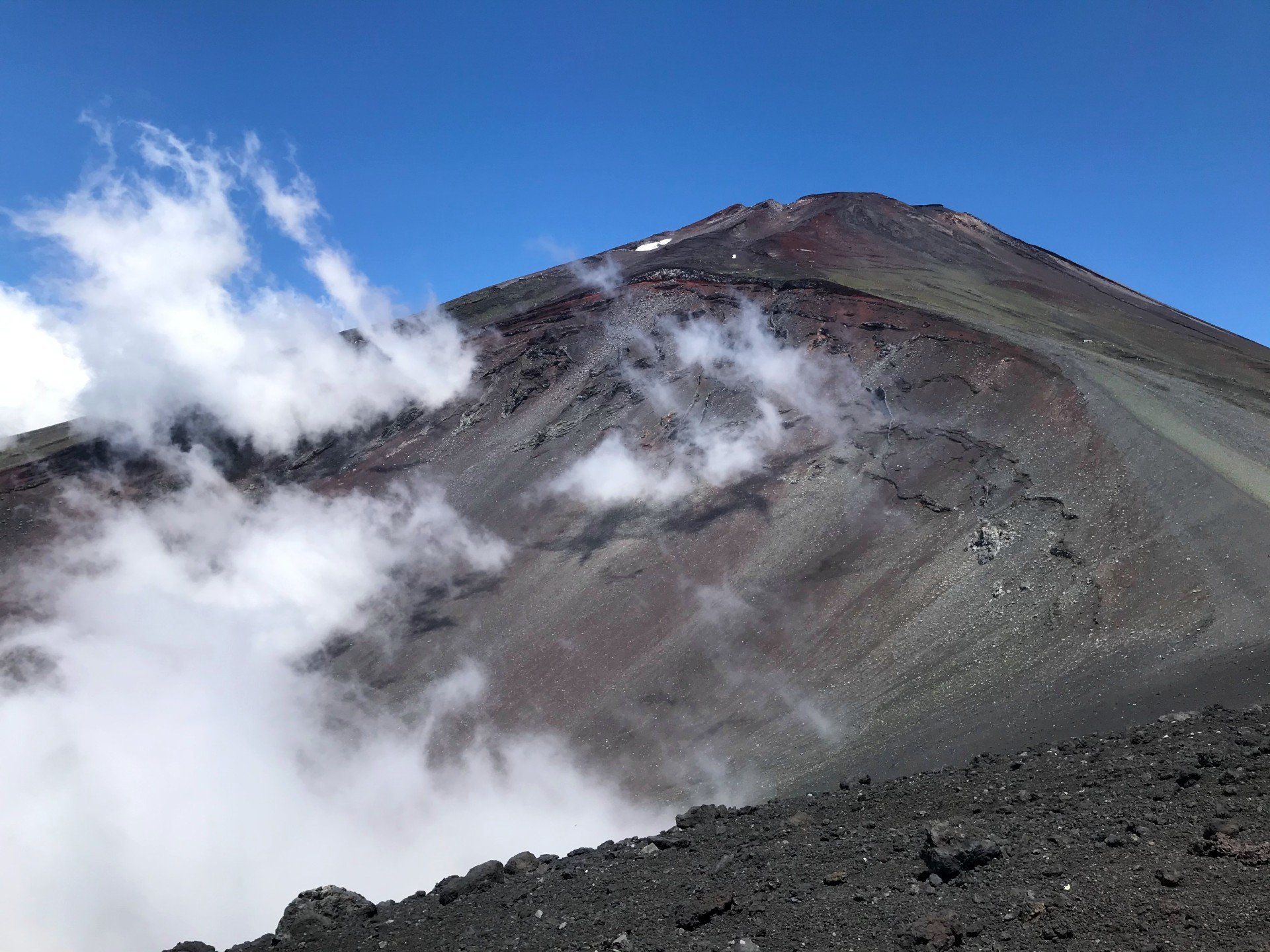Get onto the mountain for the landscapes that you have never seen before.
You had probably seen Mt. Fuji in various forms: in photographs, paintings, and illustrations or with your own eyes when you actually visited the area. And you may have felt lovely or beautiful about them.
Visual features of those you saw are mainly triangles, cones, symmetries, the top being snowcapped, etc. However, all of these are based on the views of Mt. Fuji from a distance.
When you enter the mountain and visit the sites on it yourself, you will be greeted with powerful and magnificent landscapes that are entirely different from what you see from afar.
They are as powerful as a volcano! Yes, Mt. Fuji is indeed an active volcano.
Mt. Fuji summit crater
Osawa failure
Hoei crater
1. Mt. Fuji Summit Crater
Mt. Fuji has a crater at its summit, approximately 780 meters in diameter and 237 meters deep.
Around 1500 B.C. to 300 B.C., explosive eruptions occurred at the summit. After 200 B.C., there was a complete turnaround, with fissure eruptions occurring in all directions on the flanks of the mountain, and no summit eruptions have occurred ever since.
This huge crater, which was formed more than 2,000 years ago, is a sacred area called Naiin, and Dainichi Nyorai (Mahavairocana) has been considered the central Buddha enshrined there. In addition, some of the peaks on the crater rim were likened to the world of the Buddha in the mandala, and pilgrimages called "Ohachimeguri" to walk around the crater along these peaks were made.
When you take the summit trail to trek around the sacred summit crater, you can fully enjoy the majestic panorama and also look down on the Osawa Failure from its head just below the summit.
2. Osawa Failure
A large-scale collapse site that gouges a large area of the mountainside due west of Mt. Fuji. You can't imagine it from the beautiful view of Mt. Fuji from a distance, but there you can see the spectacle of such powerful cliffs that makes you recoil in surprise.
It was once the most difficult point on the Ochudo trail circuit and was feared as being called "Iwa no Taki" (rock waterfall). The Ochudo trail is no longer a complete circuit due to the Osawa Failure.
The massive valley extends more than 2 kilometers from just below the summit to near the fifth station and has widened over the centuries into an impassable gorge some 500 meters across. The failure began more than 1,000 years ago, and it still continues little by little every day at present.
3. Hoei Crater
On the southeast slope of Mt. Fuji, there is a crater that looks as if it was carved out by the hand of God. It is the newest crater of Mt. Fuji, the Hoei Crater. It emerged from the last confirmed eruption in 1707 (Hoei 4), the "Great Hoei Eruption", the largest and most recent eruption since prehistoric times.
Hoei Crater has three craters in a row, and Hoei Crater 1 has a maximum diameter of 1.3 km and is larger than the summit crater. Strata appear on the surface of the crater. The view from the trail on the rim of the crater is a mortar-shaped landscape surrounded by Mt. Hoei and the slope of Mt. Fuji, and is magnificent and beautiful. When you descend to the bottom of the crater 1 and look up at the sky, you will be overwhelmed by the power of the rock walls reminiscent of a Greek amphitheater.
The site of the Osawa Failure, which continues to expand on the west side of the mountain, is constantly changing.
Yukishiro (slush avalanche)
When I visited there in June to check the current situation, to my surprise, I could see that the deep valley had been filled in, as shown in the photo.
Such a large amount of debris caused by slope failures and landslides sometimes flows down a gorge as a large debris flow when it rains heavily.
In addition, slush avalanches called Yukishiro, a phenomenon in which snow containing a large amount of water flows downstream, occur mainly in spring on Mt. Fuji, including Osawa Failure.
They can become debris flows while entangling rocks and earth on the way down, and their reach distance to the downstream area can also become very long. So, they have been feared for a long time.
Countermeasures against failures and debris flows in Osawa Failure began on the full scale about 50 years ago and continue to this day.
The Osawa temporary quarters, which once served the Fujiko pilgrims who crossed the Osawa Failure on the Ochudo trail circuit, are now used as a station for the construction workers.
Construction workers commute here on foot for their daily work; from here, they ride the monorail on a steep slope to the site.
Unlike the other two, Mt. Fuji Summit Crater and Hoei Crater, Osawa Failure is not directly related to the eruption. Still, it is a powerful landscape and, at the same time, a very dynamic place.
These powerful landscapes can only be experienced by reaching the sites of the mountain yourself on foot. They can never be obtained from a distance. In addition, their power and grandeur are proportional to the effort and time spent!
The order of 1 to 3 is my personal evaluation, including the journey to the site. Also, the difficulty level (relative difficulty) is in order from most (1) to least (3).
Fujisan Curator offers tours for each of them,
but I recommend you first visit Hoei Crater, which is the easiest of the three.








